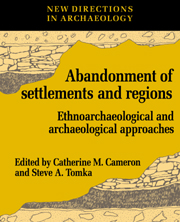Book contents
- Frontmatter
- Contents
- List of figures
- List of tables
- List of contributors
- Acknowledgments
- PART I INTRODUCTION
- PART II REGIONAL ABANDONMENT PROCESSES: ETHNOARCHAEOLOGICAL CASES
- PART III REGIONAL ABANDONMENT PROCESSES: ARCHAEOLOGICAL CASES
- 7 Local abandonments and regional conditions in the North American Southwest
- 8 An assessment of abandonment processes in the Hohokam Classic Period of the Tucson Basin
- 9 Regional settlement abandonment at the end of the Copper Age in the lowlands of west–central Portugal
- PART IV ABANDONMENT PROCESSES WITHIN SITES: ETHNOARCHAEOLOGICAL CASES
- PART V ABANDONMENT PROCESSES WITHIN SITES: ARCHAEOLOGICAL CASES
- PART VI CONCLUSIONS
- Index
8 - An assessment of abandonment processes in the Hohokam Classic Period of the Tucson Basin
Published online by Cambridge University Press: 23 May 2010
- Frontmatter
- Contents
- List of figures
- List of tables
- List of contributors
- Acknowledgments
- PART I INTRODUCTION
- PART II REGIONAL ABANDONMENT PROCESSES: ETHNOARCHAEOLOGICAL CASES
- PART III REGIONAL ABANDONMENT PROCESSES: ARCHAEOLOGICAL CASES
- 7 Local abandonments and regional conditions in the North American Southwest
- 8 An assessment of abandonment processes in the Hohokam Classic Period of the Tucson Basin
- 9 Regional settlement abandonment at the end of the Copper Age in the lowlands of west–central Portugal
- PART IV ABANDONMENT PROCESSES WITHIN SITES: ETHNOARCHAEOLOGICAL CASES
- PART V ABANDONMENT PROCESSES WITHIN SITES: ARCHAEOLOGICAL CASES
- PART VI CONCLUSIONS
- Index
Summary
Treatments of abandonment in the archaeological literature of the southwestern United States have commonly focused on adverse conditions precipitating departure from a previously inhabited locale. However, decisions as to the timing and mode of prehistoric abandonments were made in the light of conditions at destinations as well as points of departure, and cannot be fully understood from either partial perspective. The more inclusive process, which includes departure and relocation, is less amenable to study in the archaeological record because of the difficulty in establishing synchroneity between locationally disparate sets of events and their remains. Furthermore, material culture is seldom sufficiently distinctive to permit the tracking of particular persons or groups from one place to another.
In spite of these difficulties, additive trends in abandonment behavior can be approached through chronological change in comprehensive settlement patterns. Large–scale abandonments characterize the late prehistoric era throughout the Southwest. Within these broader developments, an instance of regional abandonment is examined among the Hohokam of southern Arizona (Fig. 8.1). Population dynamics that could account for patterns of Hohokam abandonment in the Tucson Basin are discussed in terms of cultural and environmental correlates. Evidence is reviewed for the nature of subsequent low–level use of abandoned territory and the relationship of this use to the economies of persisting communities.
- Type
- Chapter
- Information
- The Abandonment of Settlements and RegionsEthnoarchaeological and Archaeological Approaches, pp. 99 - 109Publisher: Cambridge University PressPrint publication year: 1993
- 8
- Cited by



